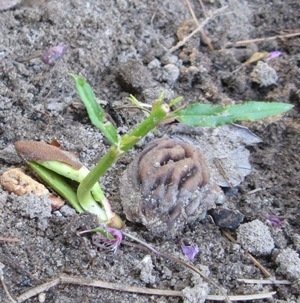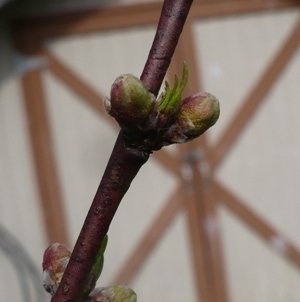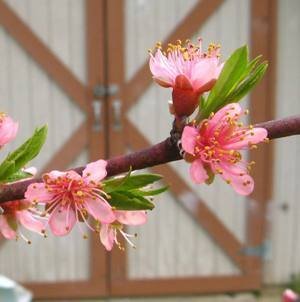





Do I dare to cultivate that baby peach that has sprung from our discarded peach pits in the backyard? Just what is involved in growing ANY peach tree?
(Editor's Note: This article was originally published on August 11, 2008 . Your comments are welcome,b ut please be aware that authors of previously published articles may not be able to respond to your questions.)
We eat peaches, we compost the remains, we find baby trees. Peach trees are apparently pretty easy to grow from seed here. But is it worthwhile to cultivate a seed grown peach in the backyard? And just how much effort is needed for success with a peach tree? Those are good questions which I will try to answer with a somewhat simplified, backyard gardener-compatible, peach plan. (And I won't complain if you want to skip down to the bottom and click on links to read several detailed peach care publications. )
Success with most fruit trees requires a gardening commitment beyond "plant, water, pick." Fruit growing raises questions about crosspolination, root hardiness, pruning and more. Mouse in one hand, coffee cup in the other, I declared: Let the research begin.
A simple "will I or won't I" on peach growing did not appear. Peaches, compared to apples or pears, do have plusses: They fruit at a young age, and are self fertile. Promising, I thought, but if peaches were really easy to grow, more people would have them. Sure enough, I was discouraged as I delved deeper. Peaches are not as cold hardy as apples or cherries. (Sultry Georgia is not the Peach State for nothing!) Even in zones that peaches tolerate, one has to consider "chill hours." Then the references advocated certain site conditions that would help my peach avoid late frosts. Really folks, how may of us have a choice of a north facing sunny slope in our backyards? And planting the darn peach is hardly half the battle. The real work comes in pruning, fertilizing, watering, and spraying to prevent multiple ailments. Maintaining one small peach tree sounded like a big project.
The professionals grow peaches from specially grown and grafted trees. But peach pits will sprout fairly easily. I have three trees to back up that claim. But why take a chance on a mutt peach? I figure I'm limiting my liability since we get most of our peaches from a local grower. In theory, our pits should come from zone suitable peach varieties. There is the question of the loss of hybrid quality, and of problem prone non-grafted rootstock. You other gardeners can understand, though, that finding a baby peach in my garden is like finding an unwanted kitten in a box on the roadside. I could hardly remain impassive and logical in the face of those innocent leaves staring up at me. I could give Peach a chance. I could practice the peach care I had studied. Even with fruit failure, I might at least know what peach culture is really like and decide whether to commit to a real (read "costs money") peach tree.
(to which, some may argue, I am no longer chronologically entitled) I nurtured two foundling peaches. Like most baby things, the growth rate was astounding.. The whippy preteen of 2008 branched out in 2009. My first ever try at "pruning to an open center" was painless (for me at least) and produced a lovely, more compact yet airy, young adult peach tree for 2010. I reveled in a full display of pale pink peach blossoms followed by hundreds of tiny fruits. Following guidelines, I thinned most of the fruit and shortened many branches early on. (An experiment with two unthinned branches convinced me that thinning works.) Baby peaches swelled in May, but June brought a record heat wave to Maryland this year. I struggled to keep up with watering the garden. Voles and nematodes potentially prowled under the mulch. Peaches dropped, and by mid July, whether to heat stress, drought, or pests, all the baby peaches had disappeared. Happily, the only sign of the many peach ailments I had feared was a few possibly fireblighted branch tips. I pruned and trashed those immediately. They were easy to spot and remove from a tree barely taller and wider than arm's length.
 Peach buds below. There are two fat fruit budswith a thin leaf bud in the center
Peach buds below. There are two fat fruit budswith a thin leaf bud in the center
 Peach flowers, April 3, 2010
Peach flowers, April 3, 2010

I started my peach care research in late winter and have had months to digest what I read, if not any actual backyard grown peaches. My sprouted pits proved that peach success is hardly guaranteed. On the plus side, I've had a free practice tree, and I feel confident I could prune and maintain a healthy, nursery grown peach tree. After much deliberation, I've developed a personal Peach Initiative Plan. If you'd like to join my Peach Corps, read the Plan, decide whether that level of commitment is doable for you, and print the spray schedule to keep it handy next year. By all means though, if you want to dot every "i" and cross every "t" of peach production, read the linked resources on this page and supplement that with a virtual trip to your nearest university extension service webpage for the best local advice.
The Plan
Year One
Subsequent years
~~~~@~~~~
Some resources I found helpful:
What will happen if I plant a peach pit? from the webpage of Michigan Peach Sponsors
Peach Orchard Establishment and Young Tree Care by Kathryn C. Taylor, University of Georgia Cooperative Extension
Pruning Peaches and Nectarines, Bob Polomski and Greg Reighard, Clemson University Cooperative Extension (HGIC 1355)
FAQ About Peach Tree Maintenance, by Mary Beth Musgrove, Alabama Cooperative Extension Service
Fruit Insect and Disease Control Guide for the Home Gardener, by Dean K. McBride and H. Arthur Lamey, North Dakota State University- Use the "Stone Fruit" section for peaches
Organic and Low-Spray Peach Production, National Sustainable Agriculture Information Service
Copyright © www.100flowers.win Botanic Garden All Rights Reserved